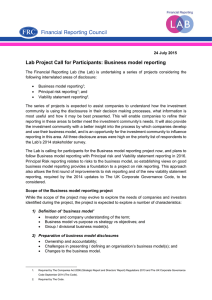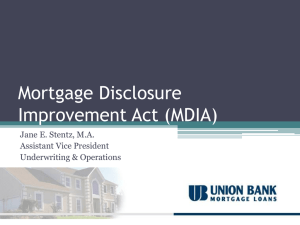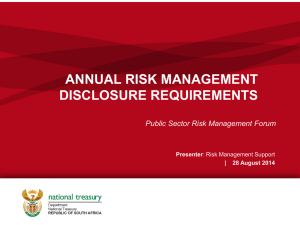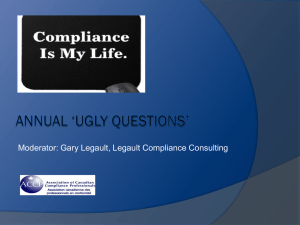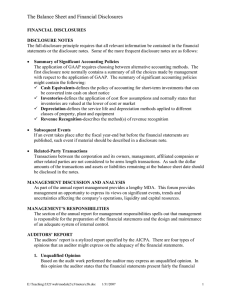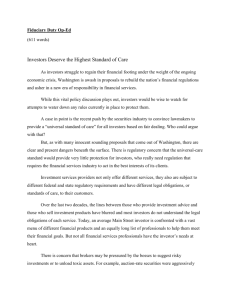May 7, 2012 Ronald W. Smith Corporate Secretary
advertisement
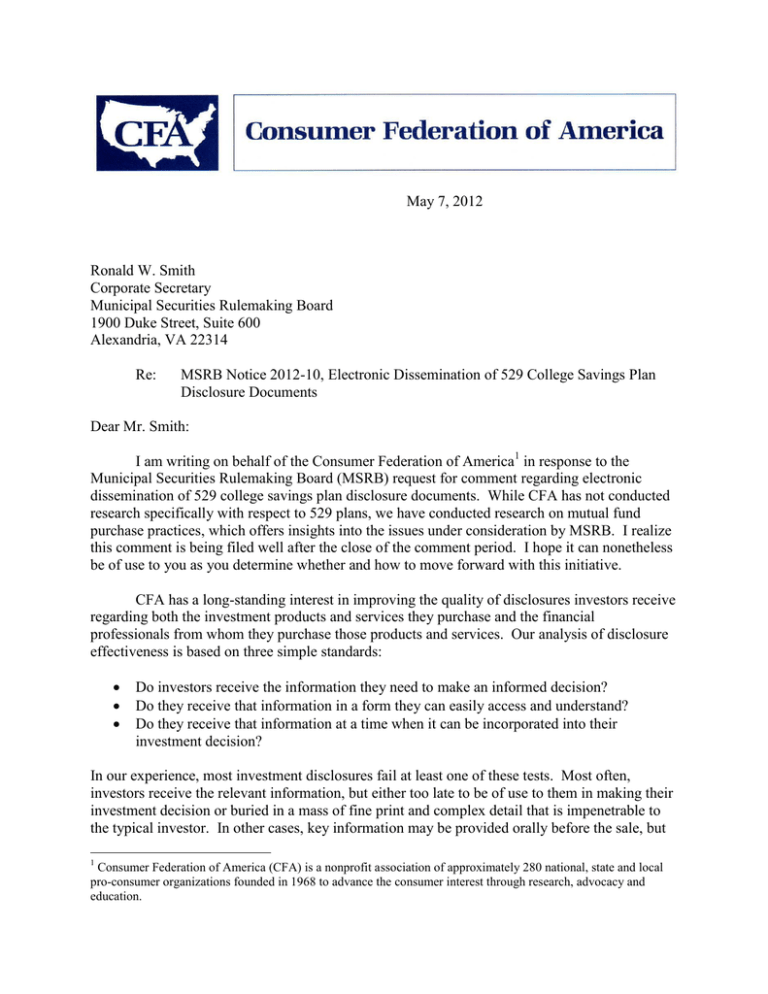
May 7, 2012 Ronald W. Smith Corporate Secretary Municipal Securities Rulemaking Board 1900 Duke Street, Suite 600 Alexandria, VA 22314 Re: MSRB Notice 2012-10, Electronic Dissemination of 529 College Savings Plan Disclosure Documents Dear Mr. Smith: I am writing on behalf of the Consumer Federation of America1 in response to the Municipal Securities Rulemaking Board (MSRB) request for comment regarding electronic dissemination of 529 college savings plan disclosure documents. While CFA has not conducted research specifically with respect to 529 plans, we have conducted research on mutual fund purchase practices, which offers insights into the issues under consideration by MSRB. I realize this comment is being filed well after the close of the comment period. I hope it can nonetheless be of use to you as you determine whether and how to move forward with this initiative. CFA has a long-standing interest in improving the quality of disclosures investors receive regarding both the investment products and services they purchase and the financial professionals from whom they purchase those products and services. Our analysis of disclosure effectiveness is based on three simple standards: Do investors receive the information they need to make an informed decision? Do they receive that information in a form they can easily access and understand? Do they receive that information at a time when it can be incorporated into their investment decision? In our experience, most investment disclosures fail at least one of these tests. Most often, investors receive the relevant information, but either too late to be of use to them in making their investment decision or buried in a mass of fine print and complex detail that is impenetrable to the typical investor. In other cases, key information may be provided orally before the sale, but 1 Consumer Federation of America (CFA) is a nonprofit association of approximately 280 national, state and local pro-consumer organizations founded in 1968 to advance the consumer interest through research, advocacy and education. only verified through written disclosures after the sale is complete – an approach that lends itself to abuse and is difficult if not impossible to police effectively. Other factors often undermine the ability of otherwise effective disclosures to support informed investment decision-making. Most notably, the best disclosures in the world will be ineffective if the product itself is so complex that it requires the sophistication of a financial professional to understand. Indeed, certain products sold to retail investors are so complex we question whether even the financial professionals selling them truly understand whether they represent a good option for the investor and under what circumstances. In such circumstances, the typical retail investor is likely to be at a complete loss, wholly dependent on the recommendations they receive from a broker, adviser or financial planner. The fact that many of these financial professionals are subject to significant conflicts of interest and are exempt from a requirement to act in the best interests of their customers leaves investors vulnerable to abuse. As a general matter, we believe a well-designed system of Internet disclosure can help to alleviate these inherent challenges, though even the best disclosure system cannot overcome them entirely. The following are among the chief potential benefits offered by Internet disclosures. When basic disclosure documents are required to be publicly available on the Internet, barriers to providing that information early enough to allow its incorporation in the decision-making process are essentially eliminated. When information can be delivered to the investor electronically virtually instantaneously and at very little cost, opposition to pre-sale disclosure requirements can no longer be justified on the grounds that the disclosures are too costly or inappropriately delay completion of the transaction. Effective use of the Internet also allows information to be presented in ways that can enhance investor understanding. Examples may include allowing one-click access to a glossary of technical terms, supporting visual presentation of the information in ways that reduce clutter, and allowing for layering of disclosures with summary documents providing an entry point to more detailed information. Perhaps most important, requiring information to be made publicly available on the Internet allows independent third-party intermediaries (whether from personal finance media or specialized information services, such as Morningstar) to access and analyze the information and repackage it in ways that make it more readily digestible for investors. Investors can also benefit indirectly, if brokers and advisers incorporate the insights of these third-party information providers when developing their recommendations. Simply making information available on the Internet does not guarantee that it will deliver these benefits. One impediment to effective use of the Internet has been industry attempts to equate access to information on the Internet with delivery of that information. So, for example, brokers have argued that the fact that disciplinary information is publicly available on the Internet negates any need to deliver that information directly to investors. We strongly disagree. Adopting this “access equals delivery” approach to Internet disclosure assumes a level of sophistication on the part of investors that simply is not supported by the survey data or 2 experience. On the contrary, investors’ limited use of information that is made readily available to them suggests that policymakers need to be thinking about how to make information more accessible, not adopting policies that force investors to take the initiative to actively seek out that information. The same principal would apply in this context. At a bare minimum, information that is posted online should also have to be delivered to the investor. This can take the form of delivery of a link, delivery of a PDF, or some other comparable method, so long as notice of the availability of the disclosure document is prominent, not buried in other information or marketing materials. An effort should be made to draw the investor’s attention to the disclosure and to emphasize the importance of the information being disclosed. And all of this should occur at the earliest possible point in the process – for example, at or immediately following the point at which a purchase recommendation is made. Even delaying disclosures until the point of sale may mean that the information comes too late to be incorporated in the investor’s purchase decision. Another impediment to effective use of the Internet for disclosure purposes has been investor resistance. Unfortunately, CFA’s most recent research on this topic dates from six years ago, which is a lifetime in the rapidly evolving world of the Internet.2 Nonetheless, it offers a warning to those who would forge ahead with an Internet-only approach to disclosure. On the positive side, our survey of mutual fund investors found that the vast majority of investors today have access to the Internet and are comfortable using it for at least certain investment-related purposes. Strong majorities of individuals aged 18 to 54 expressed a willingness to use the Internet to obtain general information about mutual funds and to research individual funds. A majority of individuals in the youngest three age groups (18-44) expressed a willingness to use the Internet to receive reports and disclosure documents. On the other hand, more than two in ten survey respondents indicated they would not use the Internet at all, including a majority of those 65 and older. And, among current investors who purchased most of their funds from a financial services professional, fewer than half indicated they would be willing to receive periodic reports or disclosure documents for the funds they own over the Internet. Just over a third indicated they would be willing to use the Internet to communicate with their financial services professional. It is certainly possible that in the six years since that survey was conducted, progress has been made in overcoming residual investor resistance to Internet disclosures. It seems unlikely, however, that such resistance has been eliminated entirely. The logical conclusion is that we are in a transitional period, and disclosure policies should be designed accordingly. While each year likely brings us closer to a point at which Internet disclosures will supplant traditional paper disclosures, we are not yet at a point where we can eliminate paper disclosures entirely. In the interim, it is important to ensure that investors who either do not have ready access to the Internet for personal financial management tasks or who are not comfortable using the Internet 2 Barbara Roper and Stephen Brobeck, “Mutual Fund Purchase Practices,” June 2006, available here. 3 for this purpose are not disadvantages. They must retain the ability to receive paper disclosures without having to jump through hoops to do so. Our research also indicates that 529 Plan disclosure documents are likely to be of greatest use to those investors who invest directly, rather than through a financial intermediary. In our survey of mutual fund purchase practices, we found that direct purchasers of mutual funds were significantly more likely to have weighed key factors, such as fund fees and fund risks, when making their investment decision, and were more likely to say they had read the prospectus. This should come as no surprise, though even among members of this group, review of the prospectus appears to be more limited than experts recommend. Willingness to research purchases was significantly more limited among those who purchased primarily from an investment professional. Specifically: Nearly three in ten (28 percent) current mutual fund owners who purchased most of their funds through a professional said they relied totally on that professional’s recommendation, without doing any additional research. Another 36 percent said they relied a great deal on the recommendation of the financial services professional, but reviewed some written material about the fund before the purchase.3 While improving disclosure design and delivery requirements may help to increase the number of such investors who review disclosure documents, there is a limit to what we can rationally expect to achieve. After all, it is reasonable to assume that a major reason many investors choose to rely on a professional for recommendations is precisely because they lack the time, expertise, and inclination to research investment decisions themselves. Despite these limitations, we believe posting 529 Plan documents on EMMA has the potential to benefit investors. As discussed above, for investors to receive those benefits: Those who sell the plans must continue to be subject to a requirement to deliver the disclosures to investors. Simply informing investors that the information is available online would not be sufficient. Delivery should be required to occur at the earliest possible point in the transaction, ideally at the point of recommendation. Notice of the disclosures should not be permitted to be buried in other information or obscured by marketing material. Investors who prefer paper disclosure for whatever reason should be able to choose paper delivery without impediment. 3 For this latter group, it is impossible, based on the results of this survey, to know for certain what types of material they reviewed. While that written material could include a fund prospectus or Morningstar report, it could also simply consist of marketing material. 4 Independent third-parties should have ready access to the documents in a format that allows for easy analysis and repackaging of that information, including in ways that promotes side-by-side comparisons of various plan offerings. We applaud the MSRB for its timely reevaluation of policies in this area. Please feel free to contact us if we can be of assistance as you move forward on this effort. Respectfully submitted, Barbara Roper Director of Investor Protection 5
